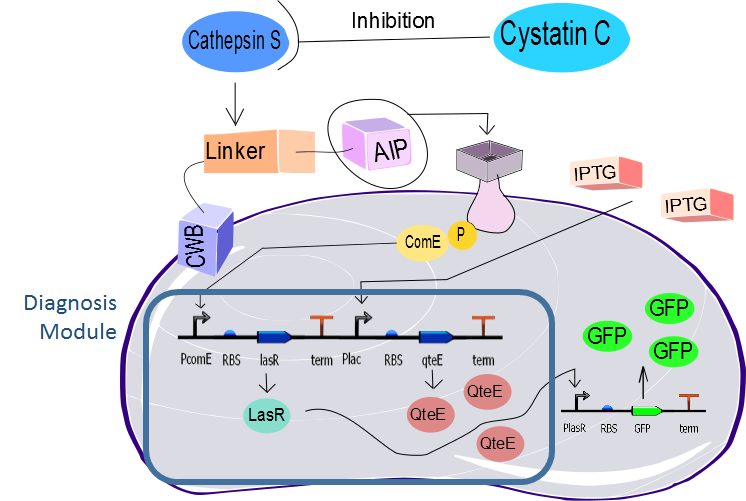Team:Brasil-SP/Project/DiagnosisModule
From 2014.igem.org
| (11 intermediate revisions not shown) | |||
| Line 1: | Line 1: | ||
| - | < | + | {{:Team:Brasil-SP/Templates/Header|headersrc=TheProjectBRASILSP.png}} |
| - | + | ||
| + | <h1>Diagnosis Module</h1> | ||
| + | One crucial step for our biodetector to work is its ability to discriminate between normal and abnormal Cys C, not just responding to the presence or absence of the same. The interaction of the proteins LasR and QteE is responsible for giving our circuit this feature. The QteE destabilize the LasR protein, removing its activity as an inducer, or in other words creating an expression barrier (SIEHNEL et al, 2010). In our system, the QteE will be under control of the lactose promoter (IPTG inducible), while the LasR production will be under control of the ComE responsive promoter. The Expression of LasR induced by ComE is direct consequence of the Cystatin C levels as explained in the Detection Module section. Having said that, we have to adjust the IPTG concentration so that only the LasR concentration originated from increased Cys C levels can generate in a positive diagnosis (probable kidney disfunction). Once we have figured that out our bacteria will be capable of giving different outputs for normal and increased Cys C levels. | ||
| + | |||
| + | <!--If the concentration of Cystatin C is normal, the activity of Cathepsin S is not sufficiently inhibited. Thus, the linker will be cleaved, releasing AIP. The AIP activates ComD, which, in turn, phosphorylates ComE. ComE activates the LasR production, so that it achieves optimal concentration to activate the promoter, even if several LasR proteins interact with qteE. Therefore, the transcription of the reporter gene, GFP, is activated. If the concentration of Cystatin C is above normal, indicating a possible kidney disease, the activity of Cathepsin S is inhibited. In this way, there will not be cleavage of the linker nor the release of AIP. Thus the chain of events is not triggered, so there is no production of the reporter gene.</div></p>--> | ||
| + | <br> | ||
| + | |||
| + | {{:Team:Brasil-SP/Templates/Image | image=Circuit_diagnosis.png | alignment=center | caption= | size=500px}} | ||
| + | |||
| + | <h2> Reference</h2> | ||
| + | #SIEHNEL R, TRAXLER B, DING D, PARSEK MR, SCHAEFER AL,SINGHA K. A unique regulator controls the activation threshold of quorum-regulated genes in <i>Pseudomonas aeruginosa</i>. <b>Proceedings of the National Academy of Sciences USA </b> 2010, 107(17):7916–7921. | ||
| + | |||
| + | |||
| + | {{:Team:Brasil-SP/Templates/Footer}} | ||
Latest revision as of 00:22, 18 October 2014
Diagnosis Module
One crucial step for our biodetector to work is its ability to discriminate between normal and abnormal Cys C, not just responding to the presence or absence of the same. The interaction of the proteins LasR and QteE is responsible for giving our circuit this feature. The QteE destabilize the LasR protein, removing its activity as an inducer, or in other words creating an expression barrier (SIEHNEL et al, 2010). In our system, the QteE will be under control of the lactose promoter (IPTG inducible), while the LasR production will be under control of the ComE responsive promoter. The Expression of LasR induced by ComE is direct consequence of the Cystatin C levels as explained in the Detection Module section. Having said that, we have to adjust the IPTG concentration so that only the LasR concentration originated from increased Cys C levels can generate in a positive diagnosis (probable kidney disfunction). Once we have figured that out our bacteria will be capable of giving different outputs for normal and increased Cys C levels.
Reference
- SIEHNEL R, TRAXLER B, DING D, PARSEK MR, SCHAEFER AL,SINGHA K. A unique regulator controls the activation threshold of quorum-regulated genes in Pseudomonas aeruginosa. Proceedings of the National Academy of Sciences USA 2010, 107(17):7916–7921.
 "
"

